Connections and the Phonograph Industry
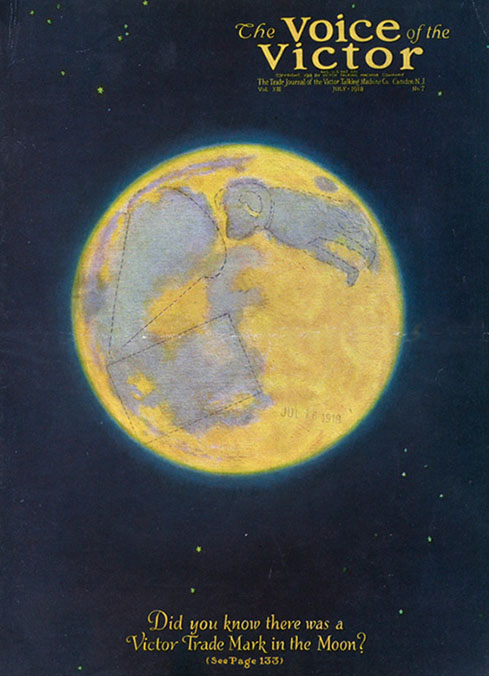
Connections
Created by a Talking Machine and an Industry
By Doug Boilesen 2020
Phonographia are connections
with the phonograph.
Ever since the wonder of Edison's invention
was first reported in Scientific American on December 22, 1877
the phonograph has been part of popular culture. The
phonograph industry created a machine that would be marketed as a
necessity and as the best source of music and home entertainment for
everyone in the family.
The galleries of Phonographia.com
are primarily advertisements and phonograph related popular culture
connections organized by themes such as PhonoArt,
PhonoAds, and numerous Factolas
related to its evolution from the 1890's to the present day.
Bill McKibben implies
the endlessness of connections when he says in his book Falter
that "everything comes with strings attached, and you can follow
those strings into every corner of our past and present."(1).
Add the interconnections and the connections within the connections
and the magnitude of these connections becomes mind-bending. (5B)
Every product, of course,
has connections. As an industry the phonograph was unique because
it used captured sound which could be replayed and the world of music
created innumerable sources for connections. This doesn't mean it
has the most connections of any consumer product. But its captured
sounds and its sound producing machines and all of the components
of the phonograph industry can be seen as having their own universe
of connections.
Artists,
musicians, performers, producers, sound
recorders, song writers, music teachers, sheet
music, recording
studios (6B); various
music venues such
as the opera, symphonies, local bands, church choirs, minstrel shows
and broadway shows each provided content and expectations regarding
what could be recorded; copyrights (after 1909), patents,
corporations and contracts; designs and aesthetic details for how
the phonograph would work and what it would look like resulted in
more connections; raw materials for the manufacture of machines and
records, factories
and workers; marketing
strategies, record
catalogs, and advertisements
in various media; owners manuals and instructions
for operating the phonograph; jobbers
and dealers who handled specific brands of phonographs and stores
where the consumers could shop
for and listen to a phonograph or buy phonograph
accessories; mail
order and delivery
from phonograph companies and from catalogs like Sears and Montgomery
Ward with additional degrees of separation to connections like the
Rural Free Delivery Act of 1893, the typewriter
and the sewing machine.
The
Phonograph Industry
All phonograph connections
in this scrapbook contribute to the definition of the "phonograph
industry."
Examples of phonograph
connections (i.e., phonographia) originate at various points in time
and place, however, finding a connection is dependent on an individual's
interaction with an end point
and the following of its respective string to its other end.
The following are some
of those phonograph industry entry points which are part of the definition
of the "phonography industry." Each provides an opportunity
to enjoy the 'phonograph's
string theory' for viewing the phonograph's universe and a piece of
its history.
Artists
and Recording Performers
Discographies comprehensively list songs
and their artists who have recorded since April 7, 1857 when Édouard-Léon
Scott de Martinville made what is now recognized as the world's
first recording, the French folksong "Au Clair de la Lune."
Another example of connections within
those discographies is a subset of artists in the early 1900's who
were opera stars who made records and were featured in phonograph
ads. These artists added opera's prestige and implicit, if not direct
support for the message that a phonograph recording can be a substitute
for live performance. Each of these artists, of course, has their
own history and their own innumerable connections.
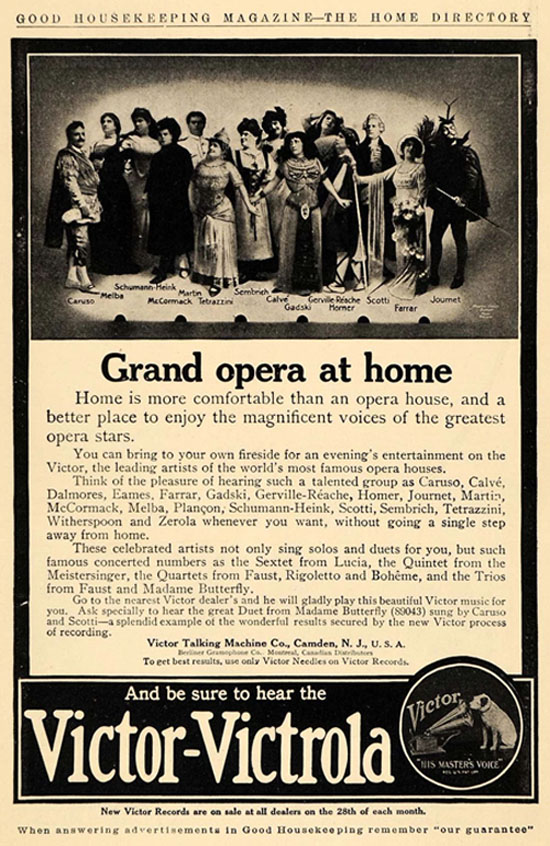
"Home is more comfortable than
an opera house...“… whenever you want, without going a single step
away from home.” 1910.
Artists
and Recording Performers - Connections within Connections
An example of a further subset of opera
recording artists can be seen by looking at six early opera stars
who made records and appeared in phonograph advertisements but who
additionally had connections with Willa Cather's opera related characters.
Phonograph popular culture examples for Cather's opera prima donnas
are seen in Phonographia's webpage titled Willa
Cather's Prototypes who were Recording Artists. (2)
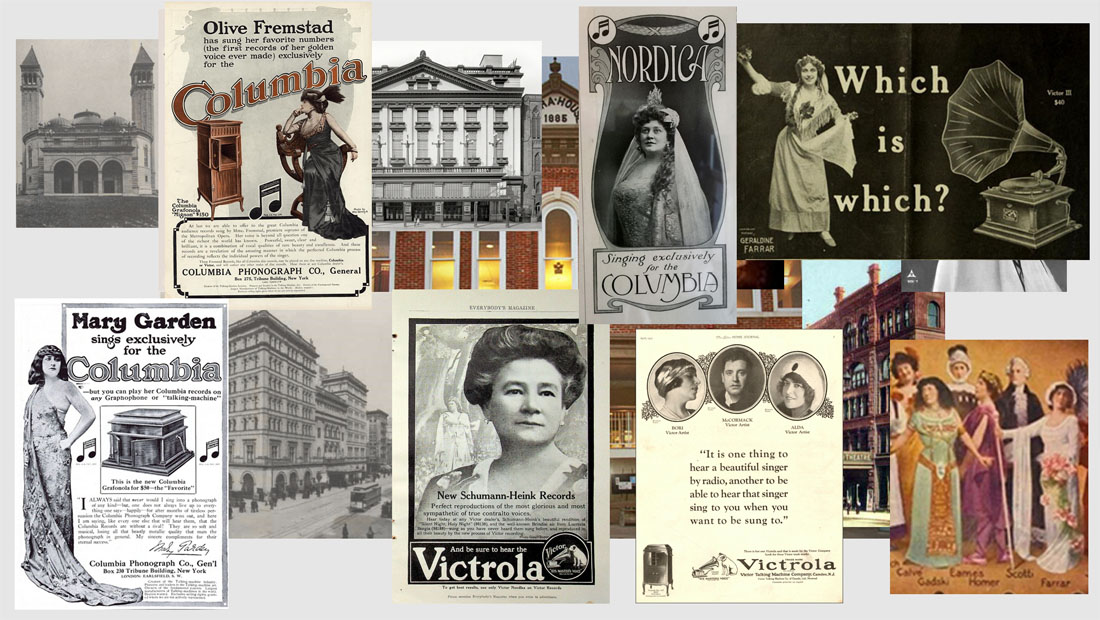
FARRAR FREMSTAD NORDICA GARDEN SCHUMANN-HEINK
BORI
Sound Recorders -
People who made sound recordings, i.e.,
the recording engineers.
We often think only about the names
of songs and artists who make records when we think about music on
records. But there is a key group of amateurs and professionals who
have made sound recordings through the decades, i.e., 'the recording
engineers.'
Relationships between
musicians, recording engineers and the phonograph industry have endless
other connections. Each of those connections likewise have supported
the advertising message that was consistent throughout the decades:
recorded music offered music to anyone, anytime and as often as one
wanted -- possible because music's "fleeting pleasure" has
been made permanent."
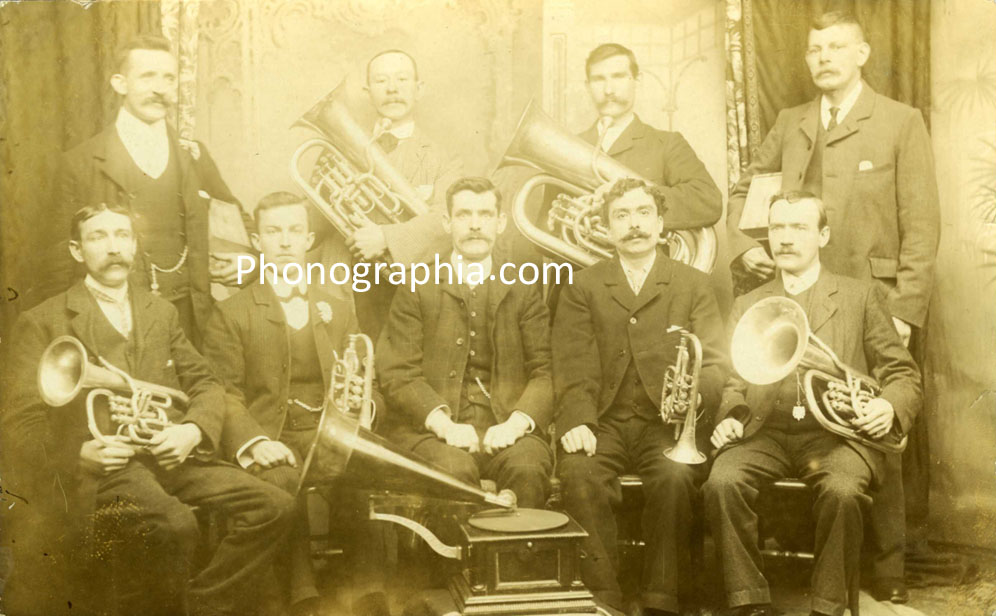
An RPPC
circa 1908, unknown location
Sheet
Music
Before the phonograph, the latest songs
were purchased by going to shops that sold sheet music.
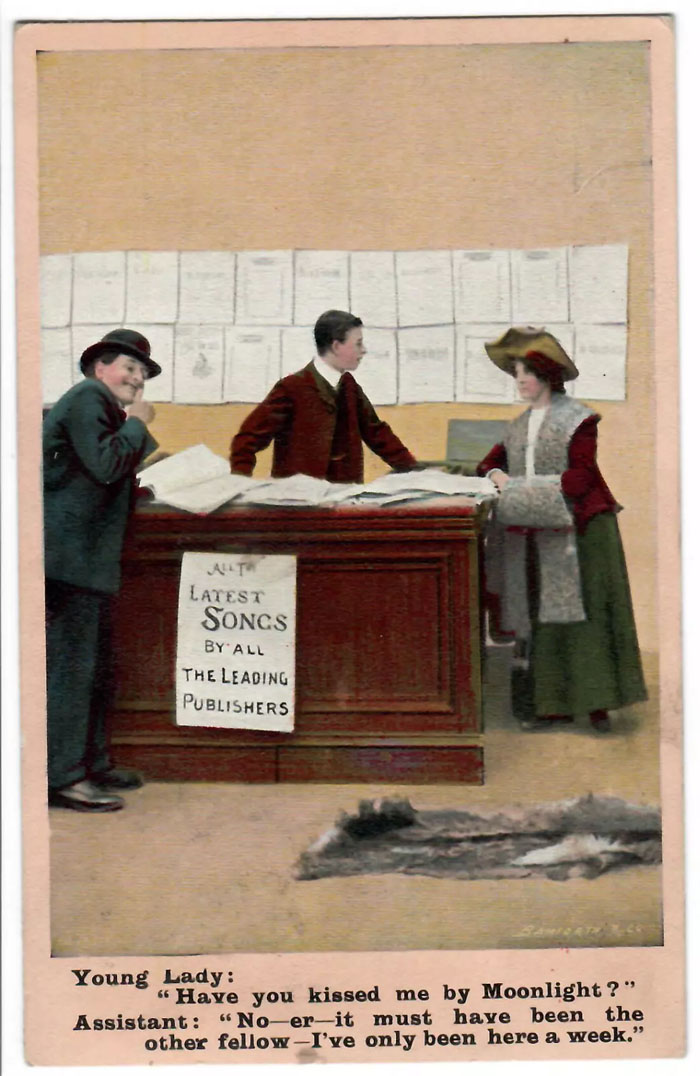
Bamforth and Co.'s Comic
Postcard, postmarked June 28, 1909.
Sheet music would continue to be important
for listening to music in the home but the phonograph's recorded songs
removed sheet music as a requirement as songs from sheet music quickly
were being turned into records by the phonograph industry.
In 1910, the sheet music for the song
Gee! But the Moon Makes Me Lonesome was released.
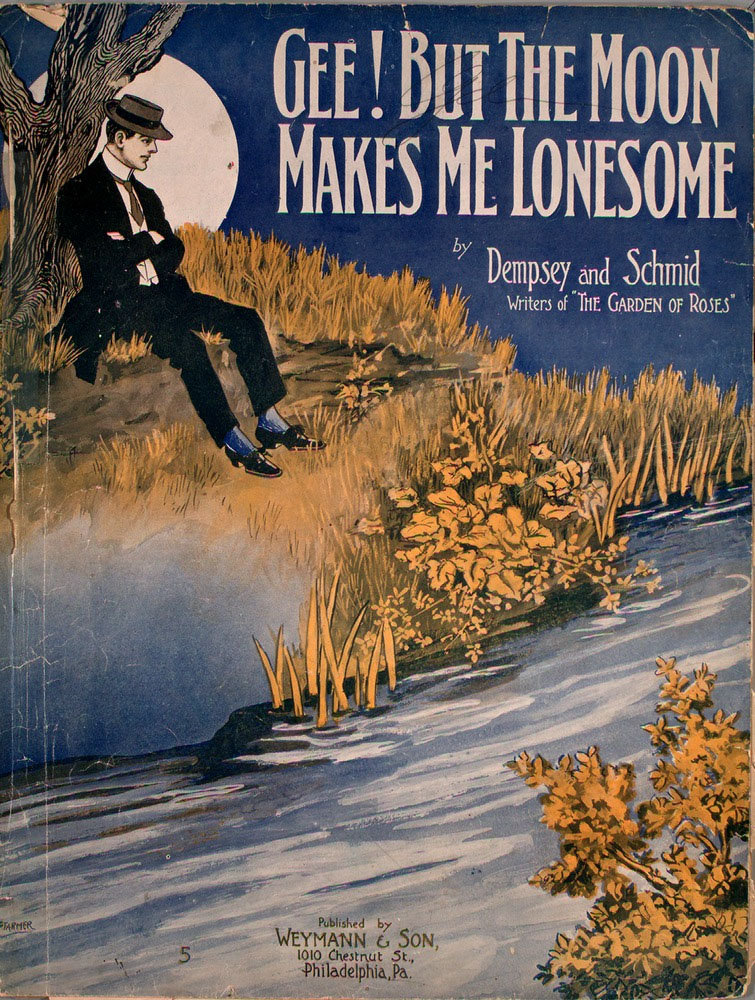
Gee! But the Moon Makes Me Lonesome.
Courtesy of The Lester S. Levy Sheet Music Collection, Johns Hopkins.
In the June 1911 Edison's The New
Phonogram announced that Record No. 694 - Gee! But the Moon
Makes Me Lonesone" sung by Mr. Manuel Romain was being released.
(3)
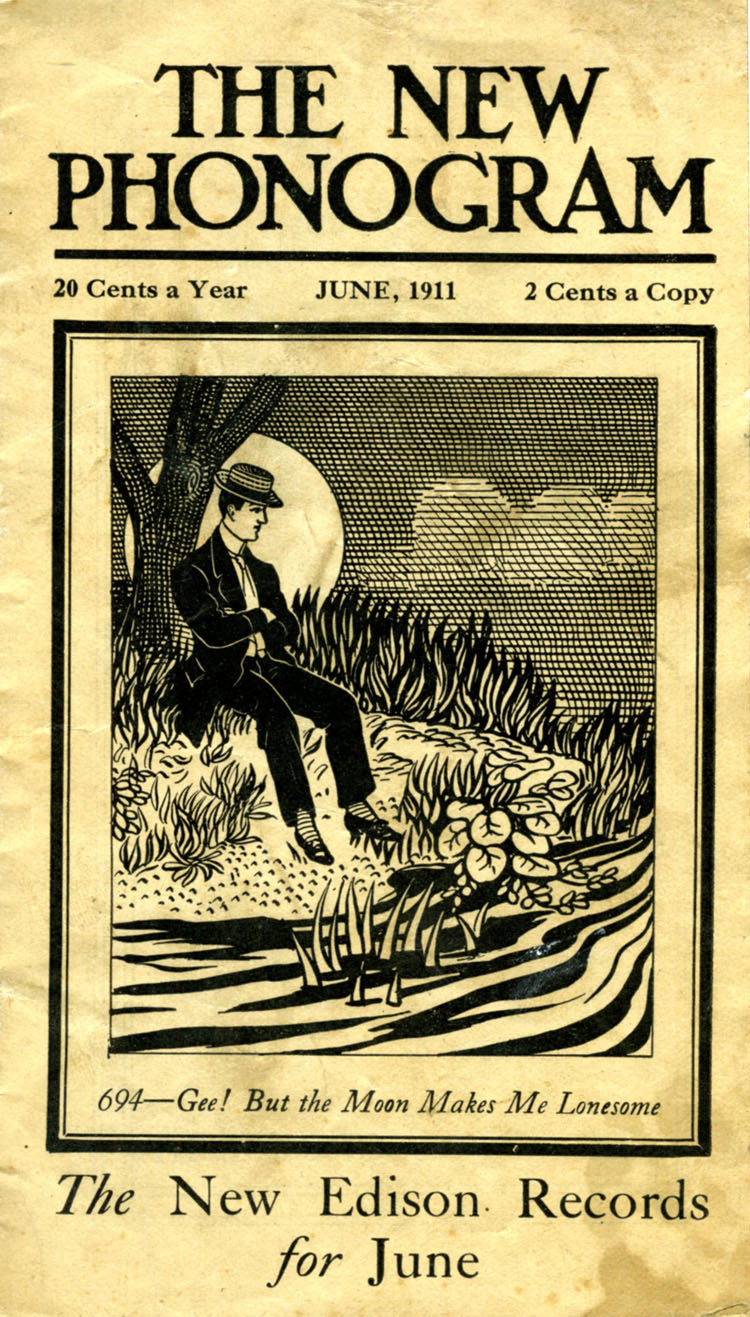
This new Edison Amberol Record No. 694,
like all recorded music, was dependent on popular culture taste, song
writers, publishers, performers, vaudeville tours, and sheet music
which normally had an illustration on its cover. Edison's Amberol
Record No. 694 was featured on The New Phonogram's cover for
June 1911 revealing one of the many connections that can be made between
music and the phonograph.
More phonograph and sheet music connections
can be seen in Phonographia's PhonoArt gallery Phono
Sheet Music Art which is a focused collection of sheet music with
phonograph themed connections.
For examples of sheet music preceding
the release of the new Victor records in January 1919, visit New
Victor Records January 1919.
Performance Venues
replaced by the Home
References to some of the prominent
venues of the world like the Metropolitan Opera House in New York
City where Geraldine Farrar sang "Carmen" or the La Scala
Theatre in Milan where "Il Trovatore" was being performed;
or general references to Broadway, the opera, vaudeville, etc. --
all of these venue references in phonograph ads were outside of the
home. And in each of these ads the consumer was reminded, often explicitly,
that even if the song by a prima donna could be heard live it would
require a ticket and then your attendance in a specific venue in some
city at a specific time and date.
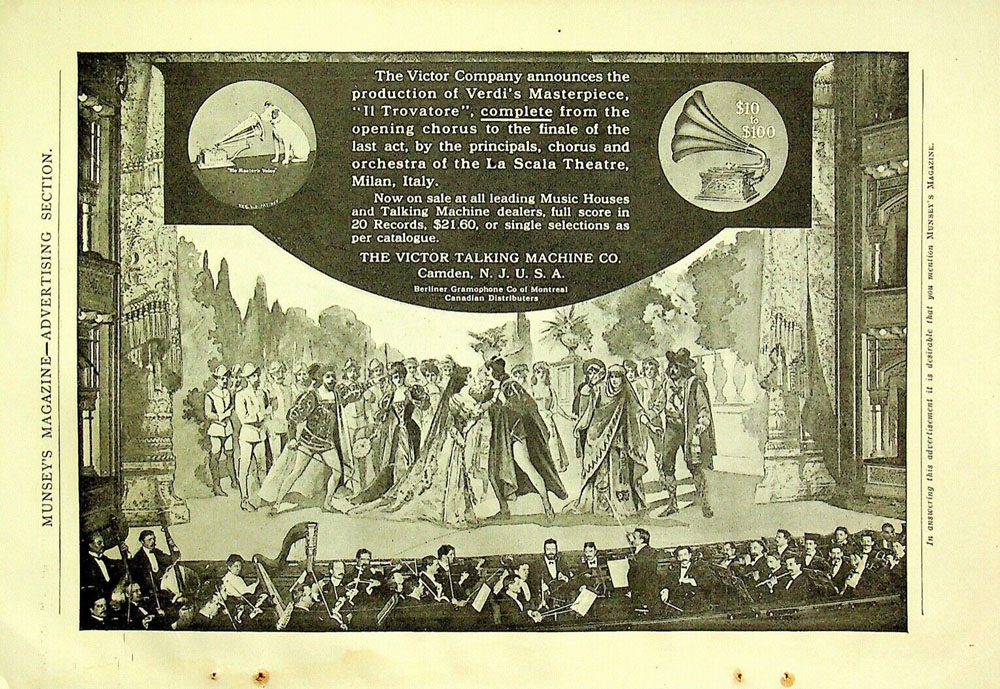
Munsey's,
Victor Talking Machine Co., 1906
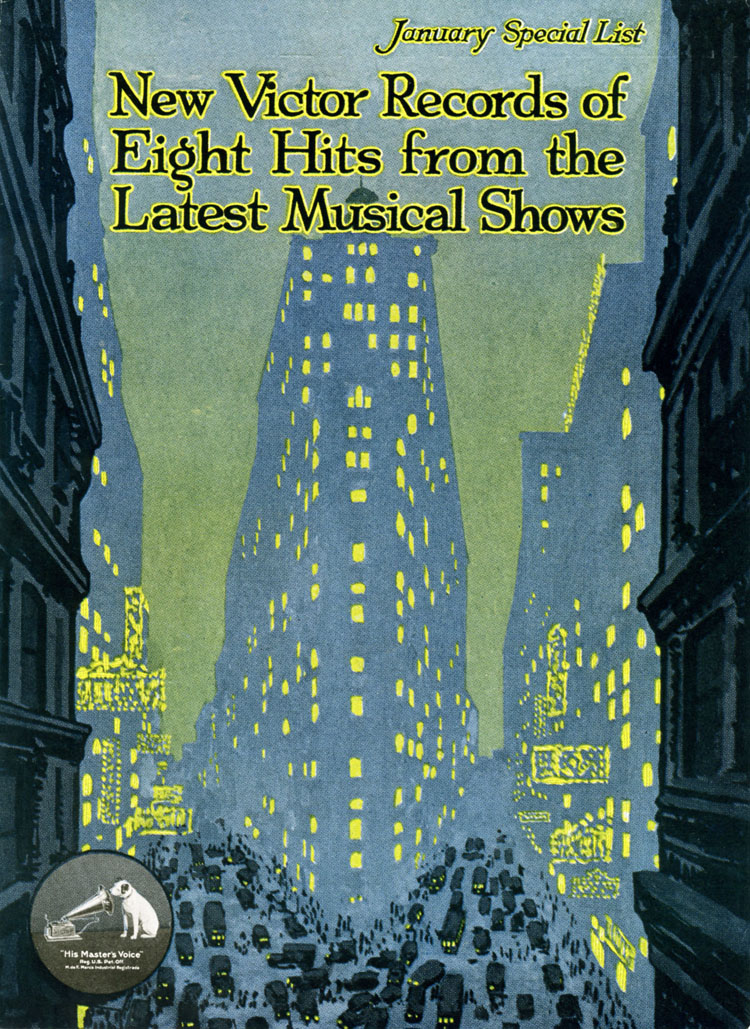
New Victor Records
Catalog, December 1916
"The best of the Broadway hits
are now available no matter how far you may be from Manhattan."
"The Edison Phonograph is the
theatre --the opera, the drama, the concert, the vaudeville---"
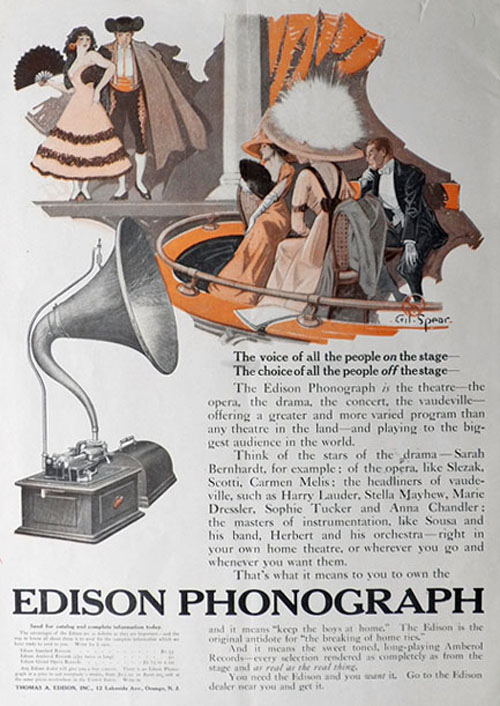
"The voice of all the people
on the stage - The choice of all the people off the stage.
Edison ad, artwork by Gil
Spear 1911
For more examples of the home replacing
the public performance venues visit Phonographia's PhonoAds
gallery The
Stage of the World.
Patents
The
Patent History of the Phonograph, 1877-1912
by Allen Koenigsberg identifies 2,118 patents and 1,013 inventors
who helped create the talking machine industry.
The big three of the early twentieth
century, i.e., Victor, Columbia and Edison, were often involved in
litigation, protecting and responding to patent lawsuits with each
other and anyone else who tried to infringe on what they said they
owned.
Edison's original patent No. 200,521
for his"Phonograph or Speaking Machine" would itself later
be used in important litigation regarding how a record is made with
attention to the definitions of a stylus indenting, etching, engraving,
or inscribing the sound waves in the recording process.
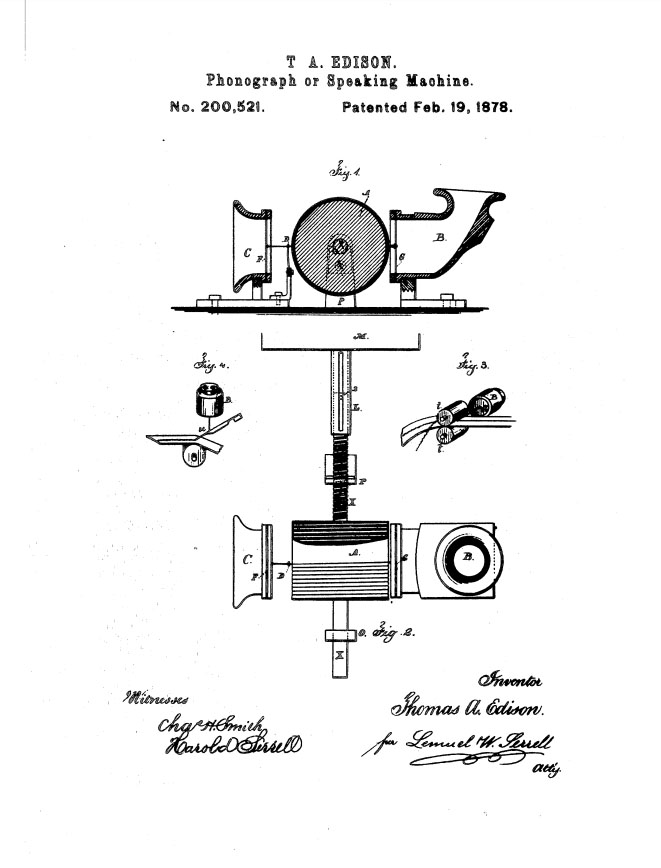
Courtesy United
States Patent and Trademark Office
Factories and Manufacturing
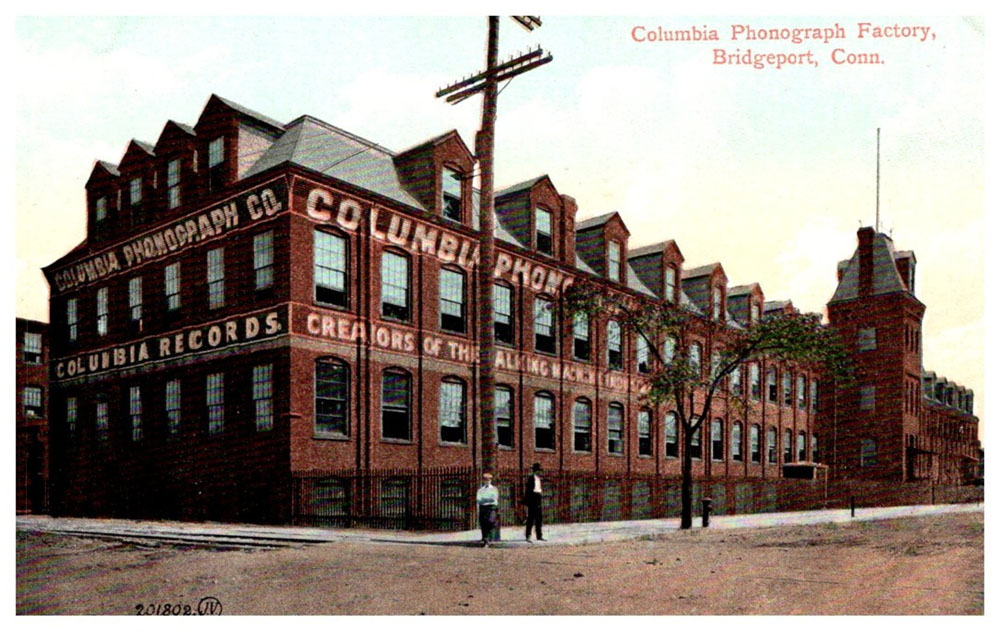
Postcard, 1909
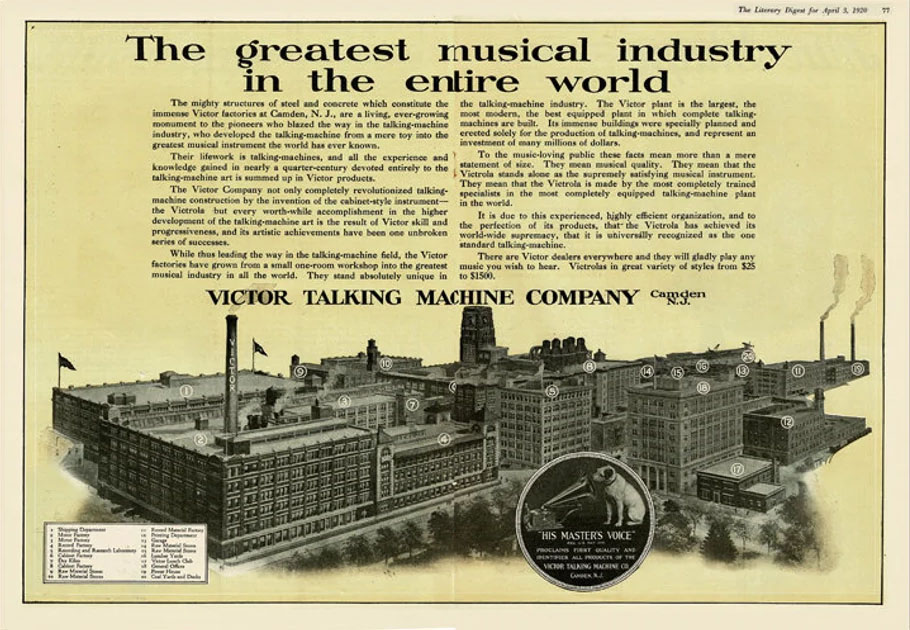
"The greatest musical
industry in the entire world," The Literary Digest for April
3, 1920
See Mainspring
Press for excellent information regarding some early Record-Pressing
Plants.
Marketing
Strategies
Early tinfoil phonographs were often
first seen in public spaces like meeting halls and opera houses where
for 25 cents you could hear "The Greatest Triumph Known to Ancient
or Modern Science!" (4A)
Years later, as it became marketed as a home entertainment device,
some phonograph dealers continued this idea of public demonstrations,
however, this time they would be free and often presented as a "Grand
Concert."
The following is an example from 1905
of the Thomas Book Store, which sold Edison Phonographs and Records
in Madison, Nebraska, renting the local Hein Opera House to put on
a free phonograph concert. The event was noted in the November 1905
edition of The Edison Phonograph Monthly.
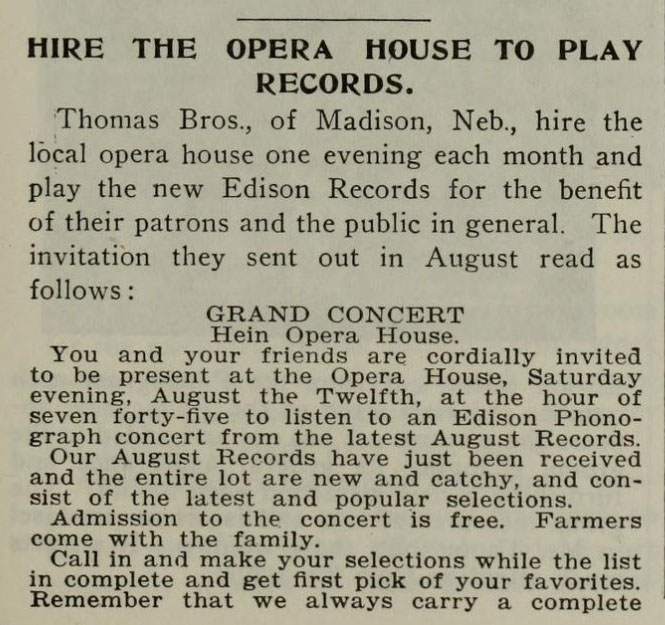

Crowd gets demonstration
in Koller's hardware store. "Finest instrument we ever saw
or heard..." "Entertainment
was better than most fifty cent shows."
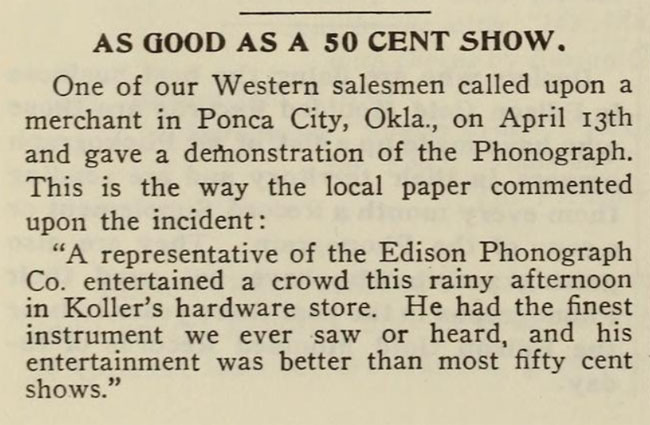
The Edison Phonograph
Monthly, May 1905
Phonograph
Stores
When the Phonograph became a machine
for the home there were several ways to get one. You could order directly
from the phonograph company perhaps in response to something you read
in a magazine's or newspaper's phonograph ad or an advertising postcard;
you could order through a catalog, like Sears or Montgomery Wards,
or from a catalog available from the phonograph and record companies;
or visit a phonograph store, music store or other local business carrying
"talking machines."
The phonograph companies had different
ways of explaining why their machine should be selected and Columbia
ads used one of the catchiest lines to invite consumers to visit their
store: "Hearing
is Believing, -- and you can hear today at the nearest
Columbia dealer's." Victor likewise used the advertising phrase
"Hearing is Believing."
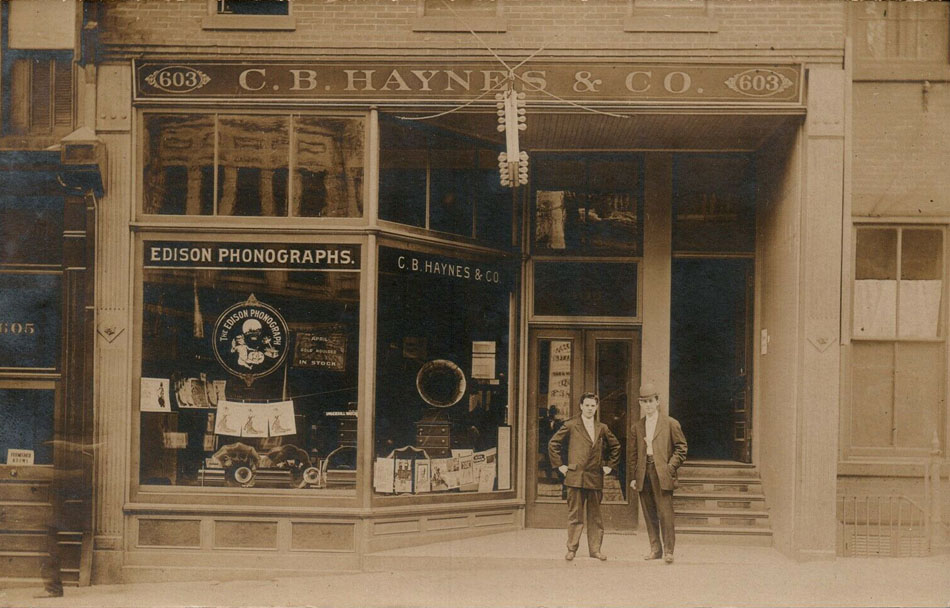
1908 C. B. Haynes &
Co., Richmond, Virginia
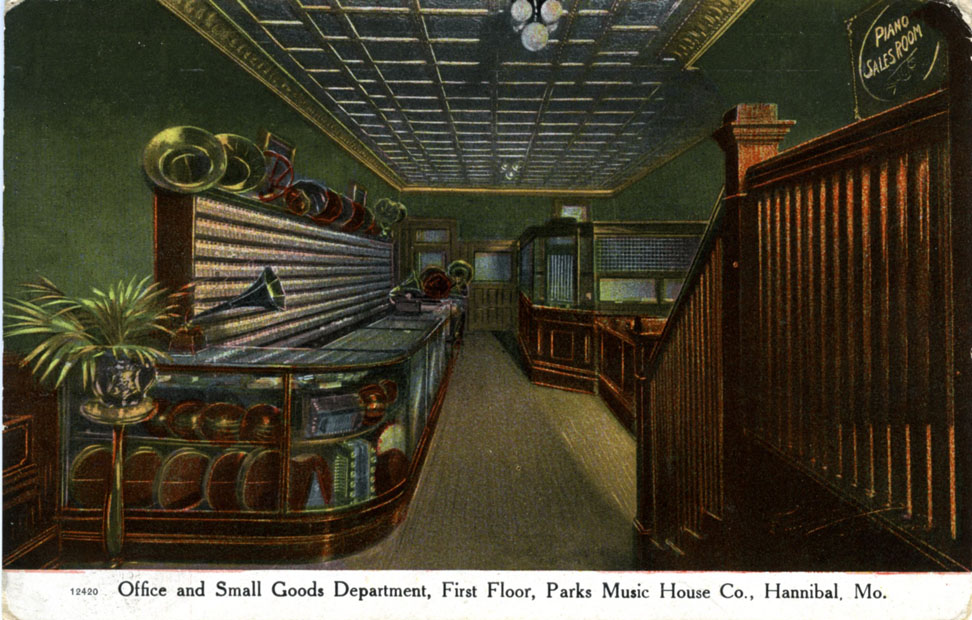
Hannibal, Missouri Music
Store with Phonographs, 1910
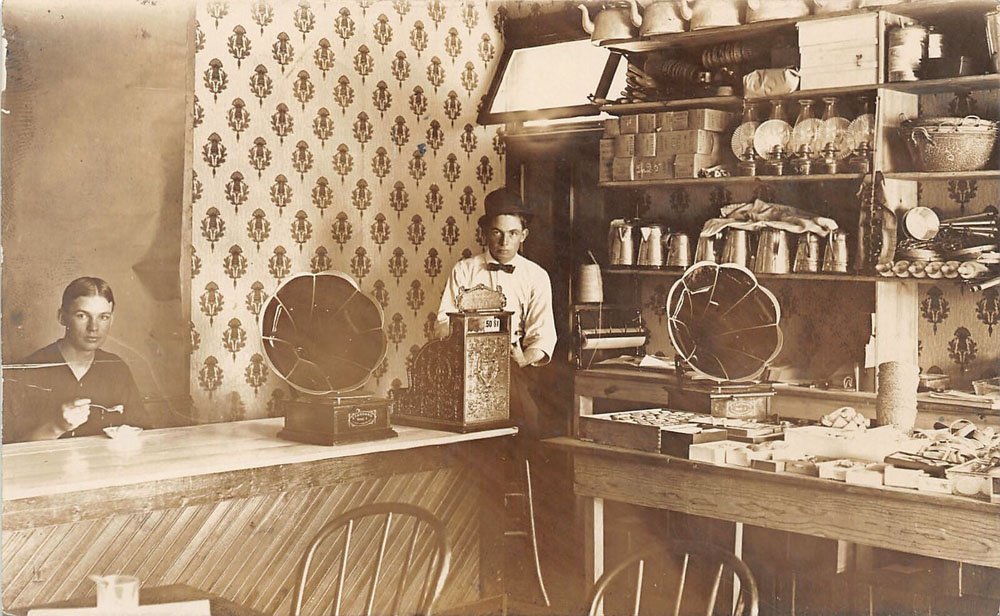
General Store with Standard
Model A Phonographs, Nebraska ca. 1910
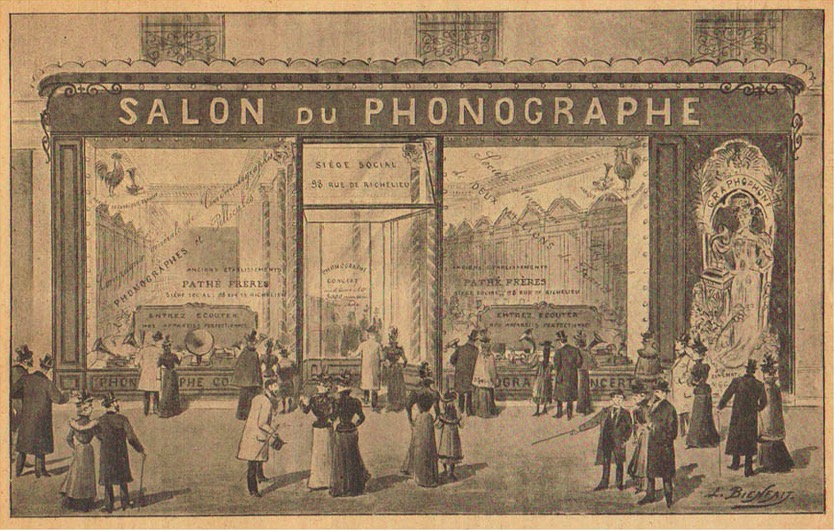
An excellent website that uses an interactive
map to identify record store dealers in Paris is Disquaires
de Paris which was designed to pay "tribute to the record
dealers and venders of phonograph cylinders, who allowed Parisians
to discover recorded sound as early as the end of the 19th century."
"Disquaires de Paris" includes all shops
in Paris from 1900 to 1940 that once sold recorded music (records
and phonograph cylinders). A significant share of these businesses
never specialized in record and cylinder sales and some existed long
before the birth of the recording industry, like the piano sellers
and luthiers that very early began selling recorded music.
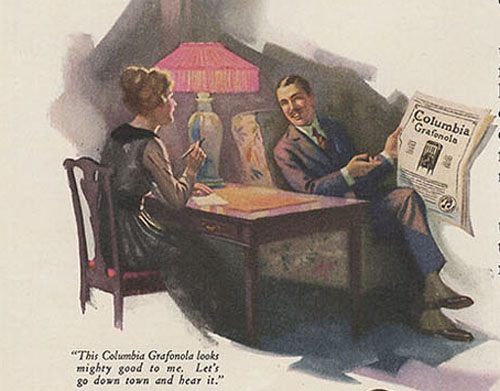
See Phonographia's Shopping
for a Phonograph for more advertising examples about shopping
for a Phonograph.
Phonograph
Accessories
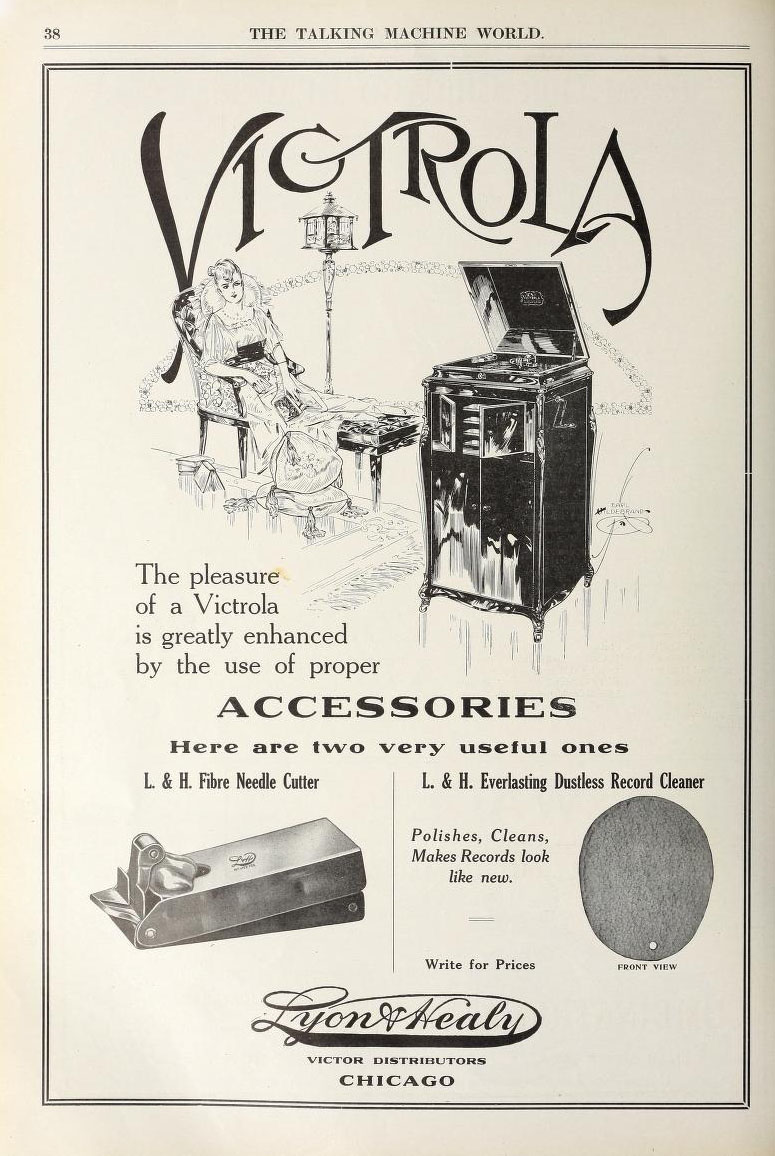
"Two very useful accessories"
-- Needle Cutter and Dustless Record Cleaner
The Talking Machine
World, July 1915
Jobbers
(Distributors)
List of Firms handling Edison Phonographs
and Records as Jobbers in Canada and the US in 1903
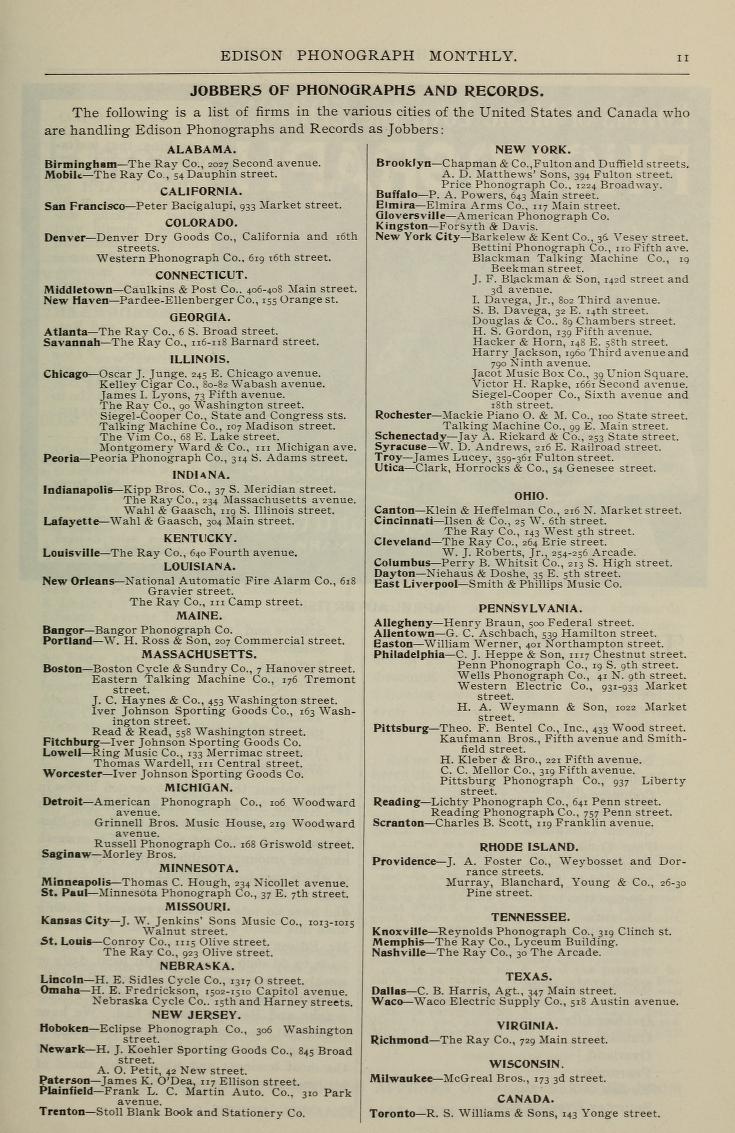
The Edison Phonograph
Monthly, April 1903
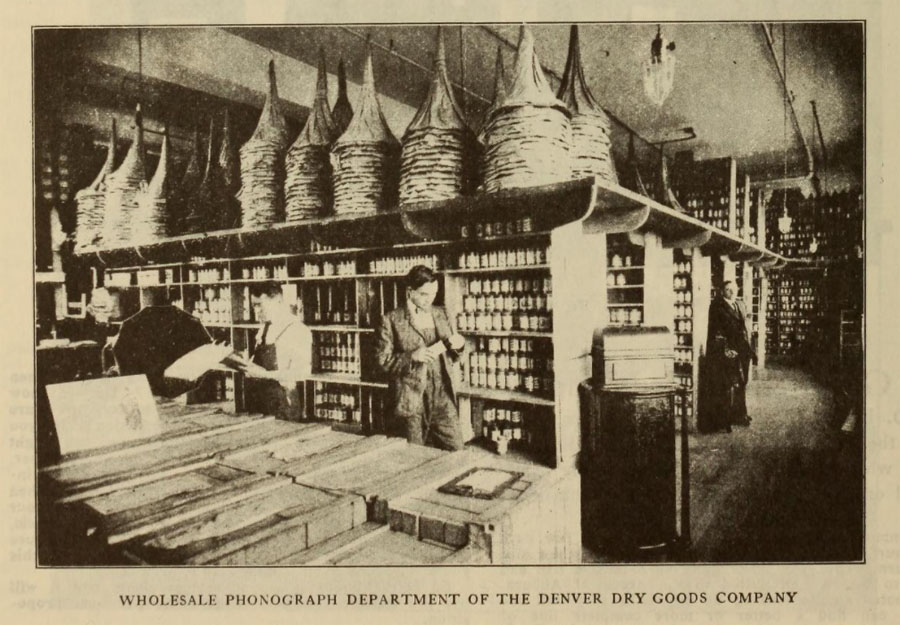
Denver Dry Goods Company (listed in
above Edison Jobbers List), The Edison Phonograph Monthly May
1908
Jobbers were wholesalers who would supply
machines and records to other stores in their area but they could
also be a local dealer store.
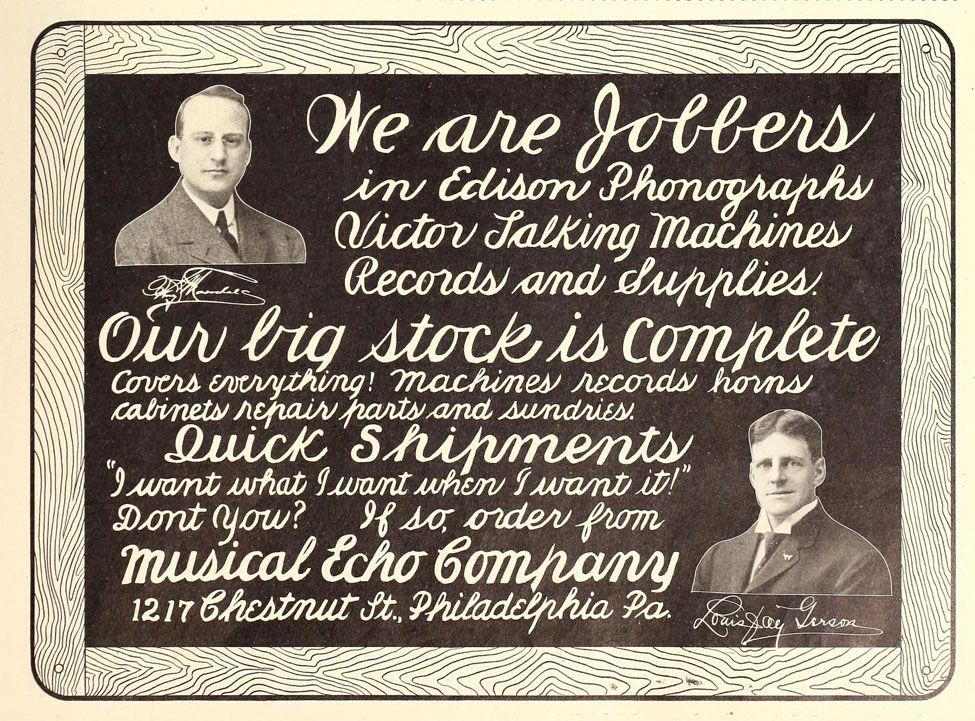
The Talking Machine
World, April 15, 1907
Advertising
List of Publications where this Edison
ad appeared in April 1903
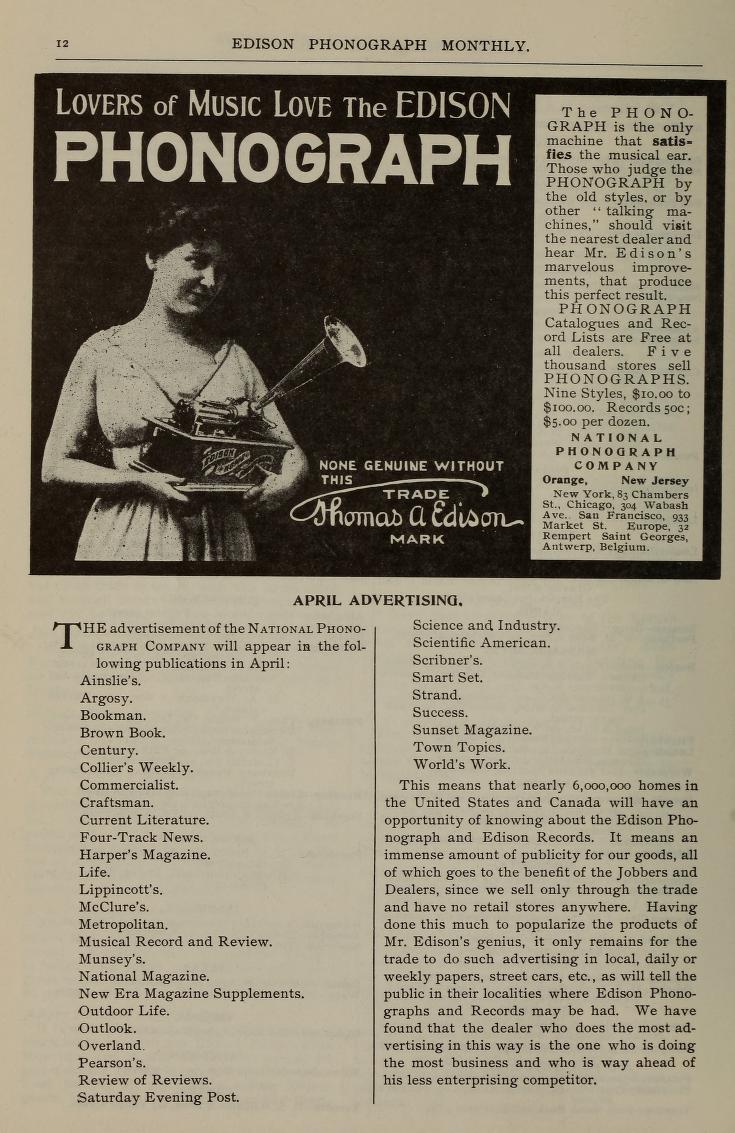
The Edison Phonograph
Monthly, April 1903
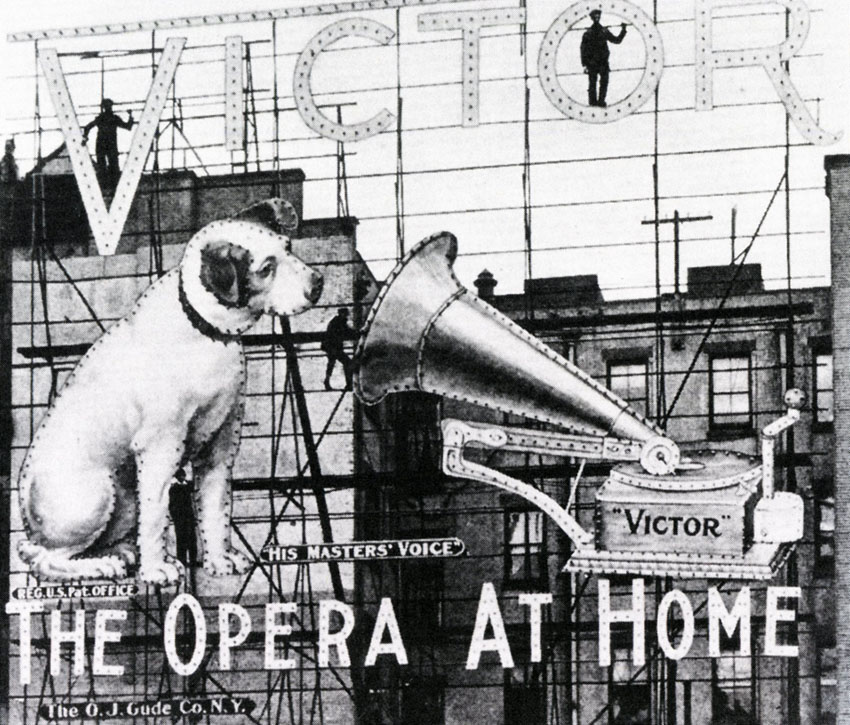
Victor Billboard in New
York's Herald Square, 1906. Courtesy Camden County Historical Society
Victor's enormous sign in New York City's
Herald Square according to historian David Suisman (5)
was "seen by an estimated eight hundred thousand people daily,"
was "illuminated by more than a thousand lightbulbs," and
was reportedly the most expensive sign in the world up to that time.
For more examples of phonograph advertising
using signs, billboards, and window displays visit Phonographia's
PhonoSignage.
Record Catalogs
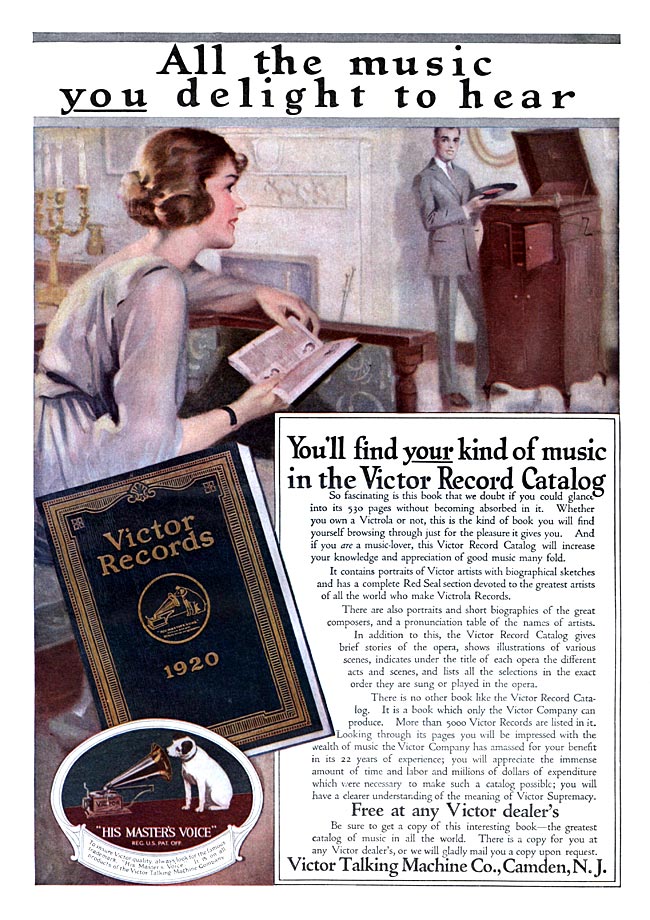
Victor Ad for 1920 Victor
Record Catalog listing more than 5000 Victor records, Needlecraft
Magazine, January 1920 (courtesy Internet
Archive)
Delivery
to the Customer
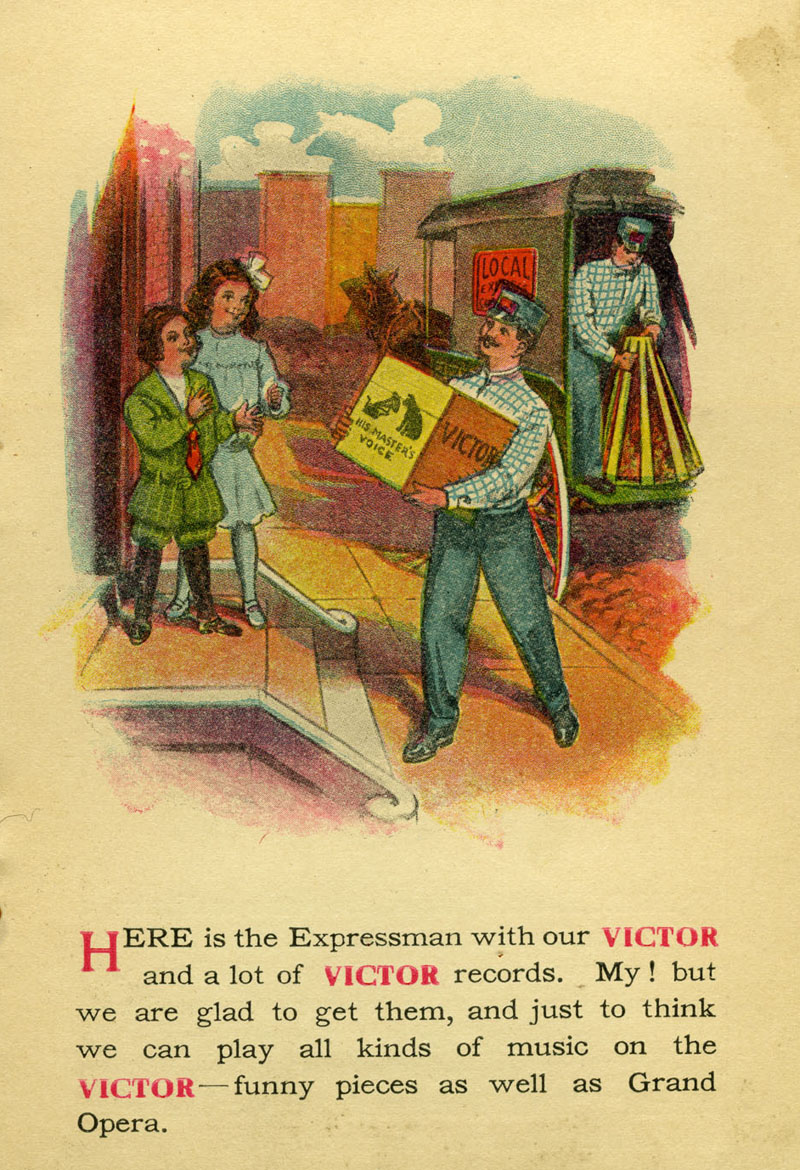
"The Victor For
Every Day in the Week" brochure - Delivery of the Victor and
Victor records. 1907
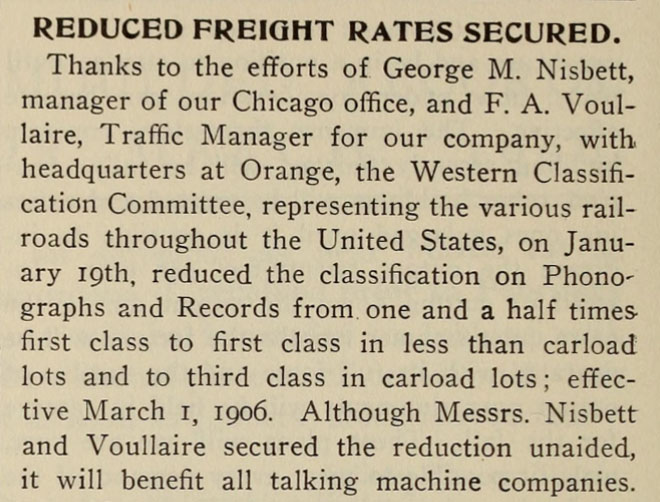
Freight Rate Reduction
Negotiated, The Edison Phonograph Monthly, February 1906
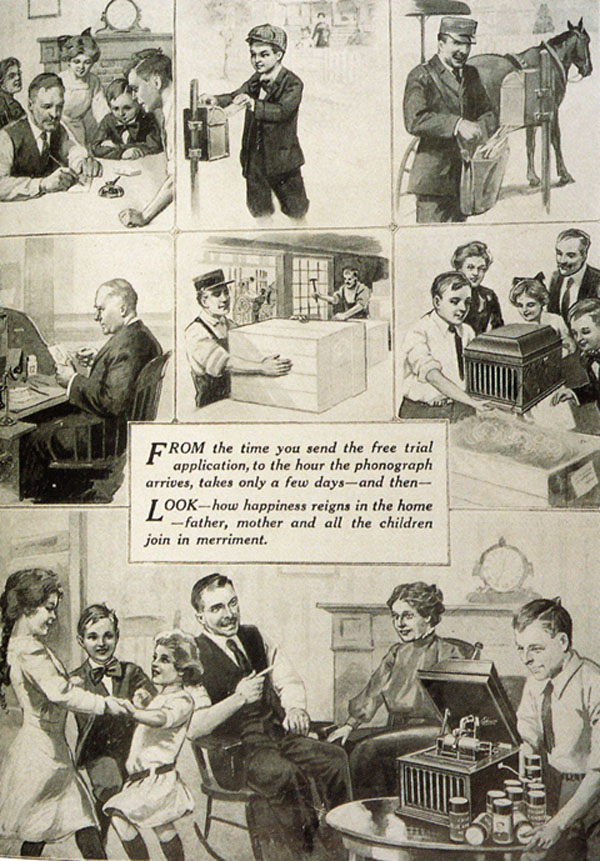
Ordering the Edison Amberola
30 - F.K. Babson Catalogue, Edison Phonograph Distributor
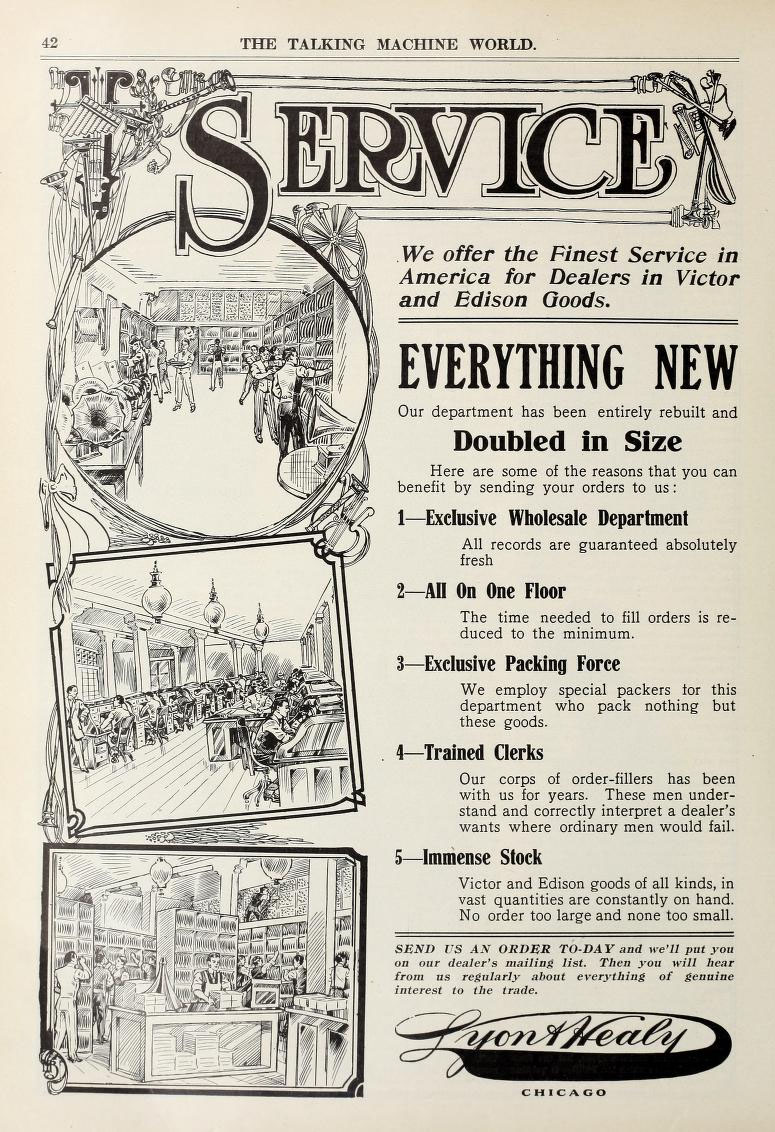
The Talking
Machine World, October 1908
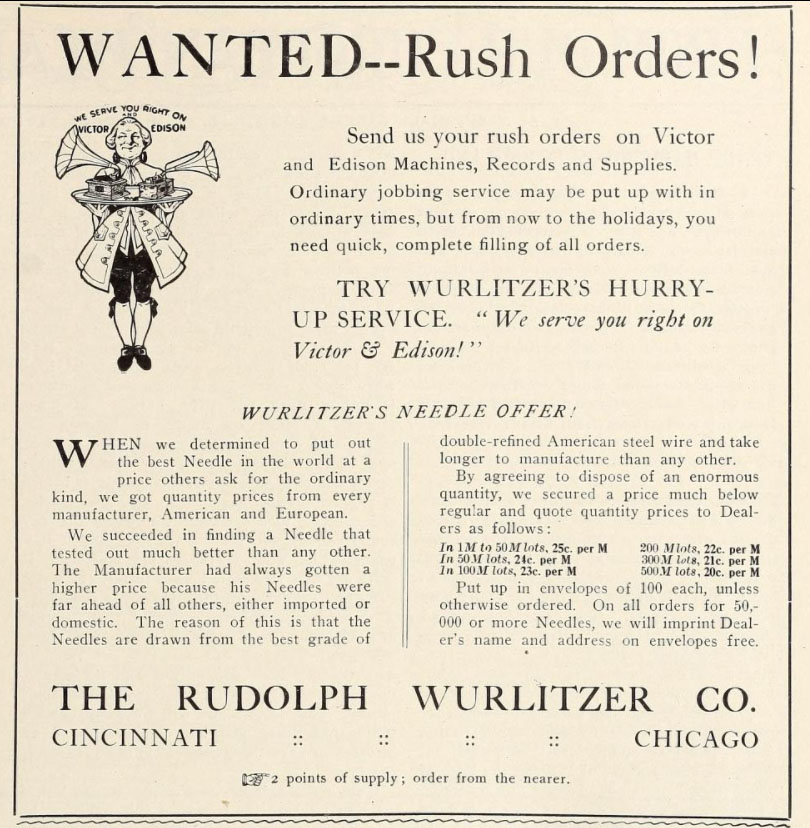
"Rush Orders!"
- The Talking Machine World, December 1908
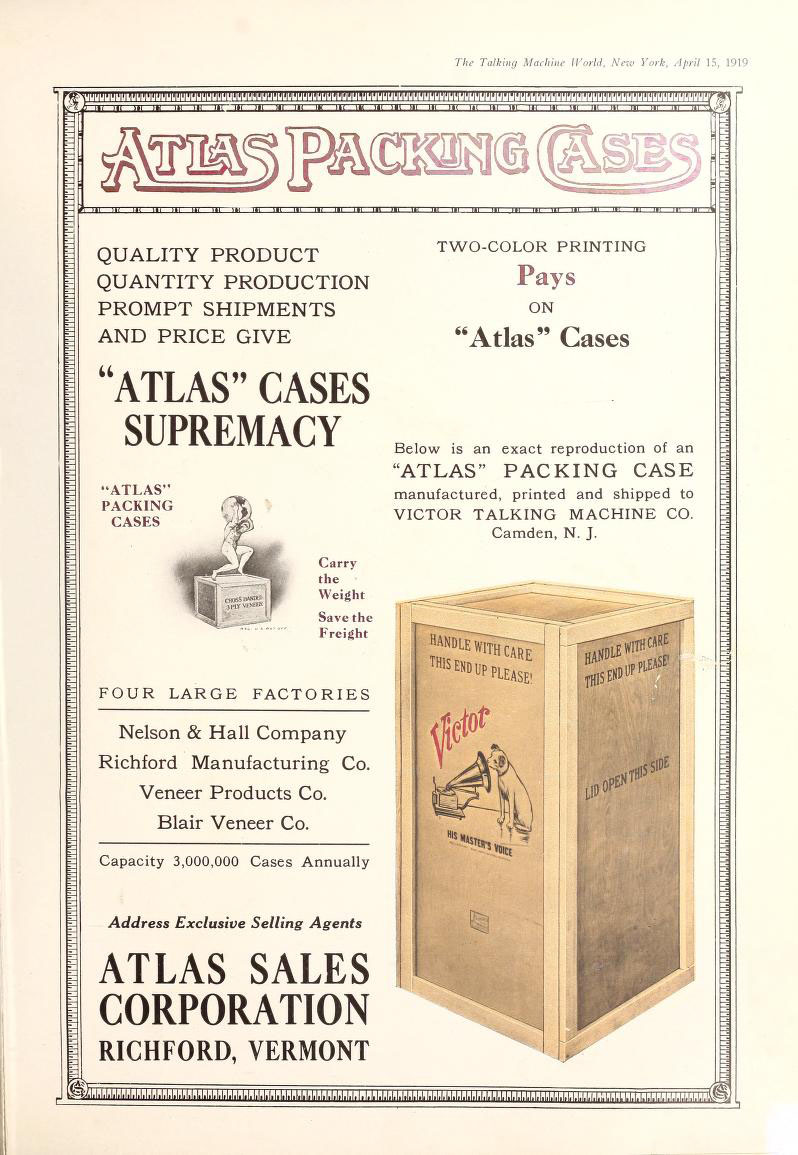
Atlas Packing Cases,
The Talking Machine World, April 1919
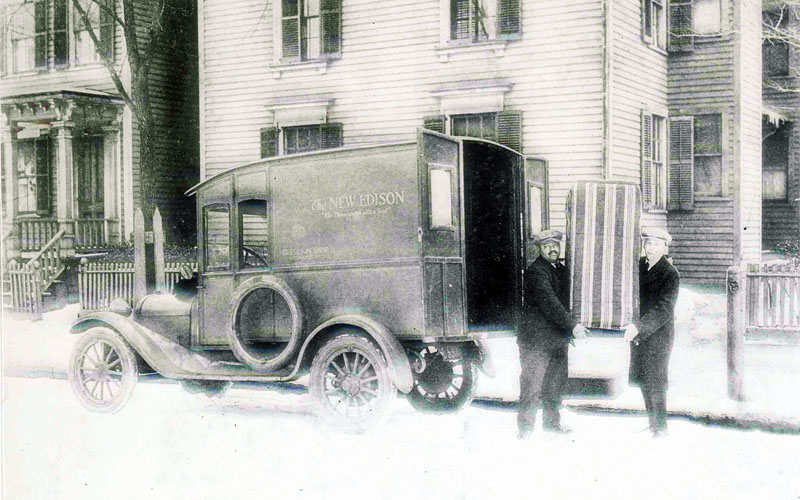
Delivery of Edison Diamond Disc Phonograph,
circa 1920 (Courtesy Thomas Edison National Historical Park)
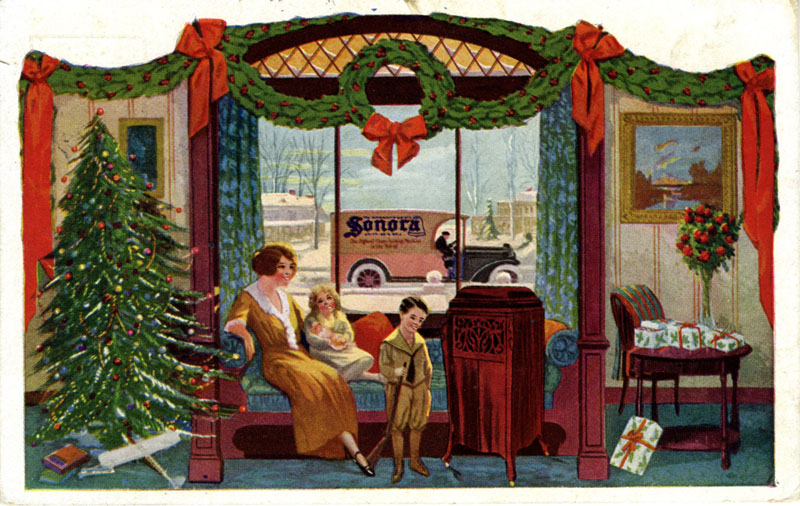
Advertising postcard,
Sonora Delivery Truck, 1920
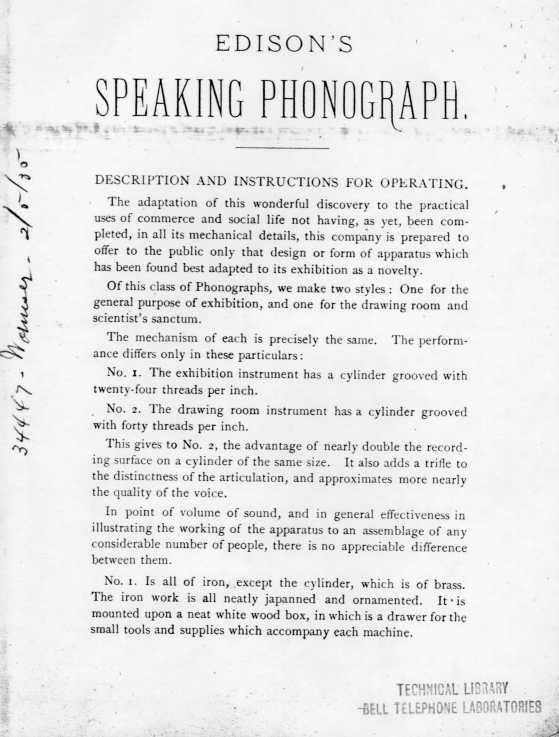
From the very beginning
instructions were published on how to operate the phonograph. This
10 page booklet "Instructions for the Management and Operation
of Edison's Speaking Phonograph" by Edward Hibberd Johnson
was published in 1878 to support the early use of Edison's tin-foil
phonograph. (Courtesy of AT&T Archives and History Center and
Rutgers University). (6)
View
the complete 1878 Instructions booklet (Thomas A. Edison
Papers, School of Arts and Sciences, Rutgers University).
Summary
Phonographs and records
are not unique in having innumerable connections throughout their
life-cycles -- all consumer products have countless connections related
to how they became a product in the context of the culture of their
time.
Phonograph connections,
however, are unique in being part of the first industry to offer a
product that altered human perception of sound with captured sounds
previously limited by the moment and place. Live performances and
a diversity of sounds became available as home entertainment to anyone,
anytime, and to be heard as often as you wanted.
Each new home and personal
entertainment device involving sound since the phonograph (7)
has continued using themes from the phonograph's earliest advertisements,
promoting the altered world of perceived sound and promising the "best
seat in the house."
The phonograph, 78's,
LPs and 45s;
radio, AM, FM; television, hi-fi, stereo and surround sound TVs; the
wire-recorder, tape recorder, 8-tracks, cassette recordings; Walkman's
and boomboxes; VHS and Betamax VCRs; CDs, HDCDs, SACDs; Laserdiscs
and CED Video Discs, DVDs, Blu-rays, 4K Ultra Blu-rays; computers
with digital and multiple audio formats, music streaming services
-- each and more offered their revised version of what the original
phonograph said it could do because of its revolution of recorded
sound, bringing entertainment and the "Stage of the World"
into your home as if you were a king, or a millionaire or the possessor
of Aladdin's Lamp.
The Phonograph
was a wonder and a consumers' dream.
It's a revolution still
turning.
"Seventh row, center.
Forever."©
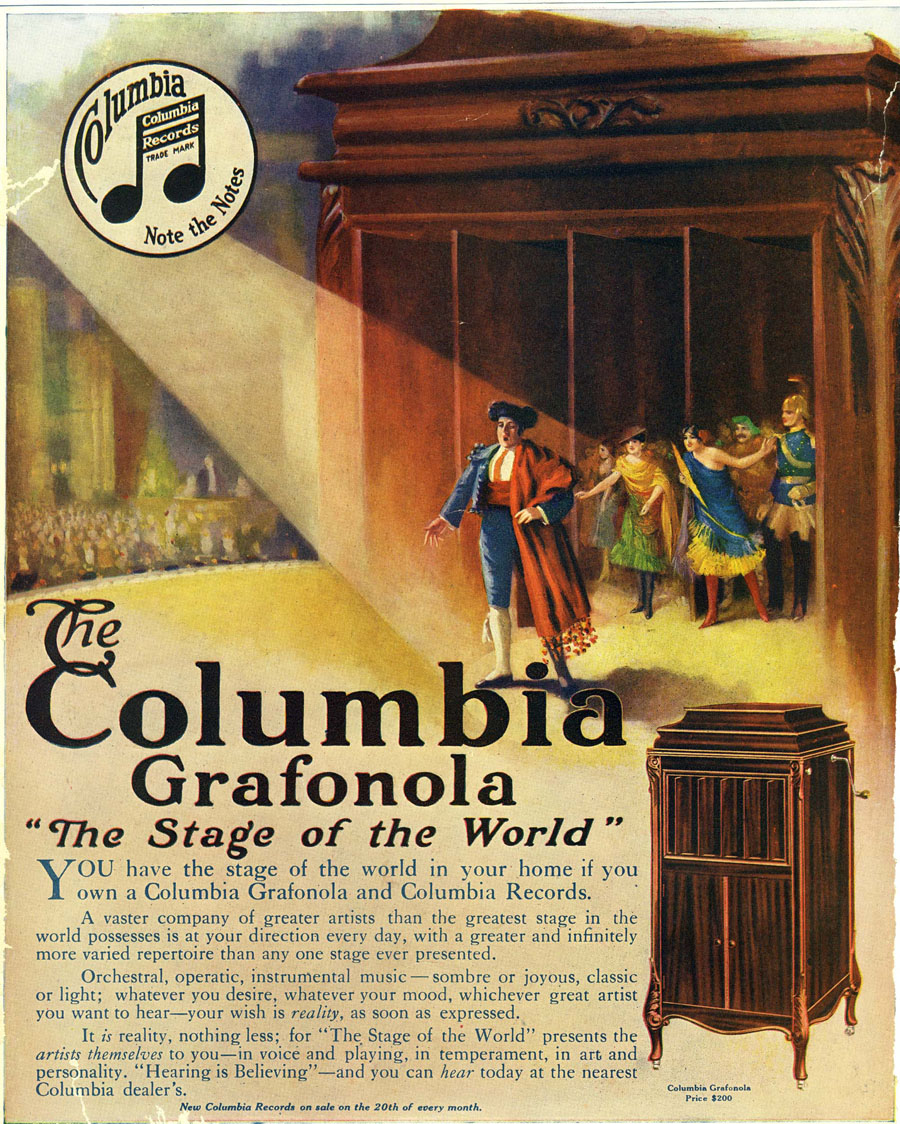
"It is reality, nothing
less; for "The Stage of the World" presents the artists
themselves to you..." Columbia Grafonola, 1916
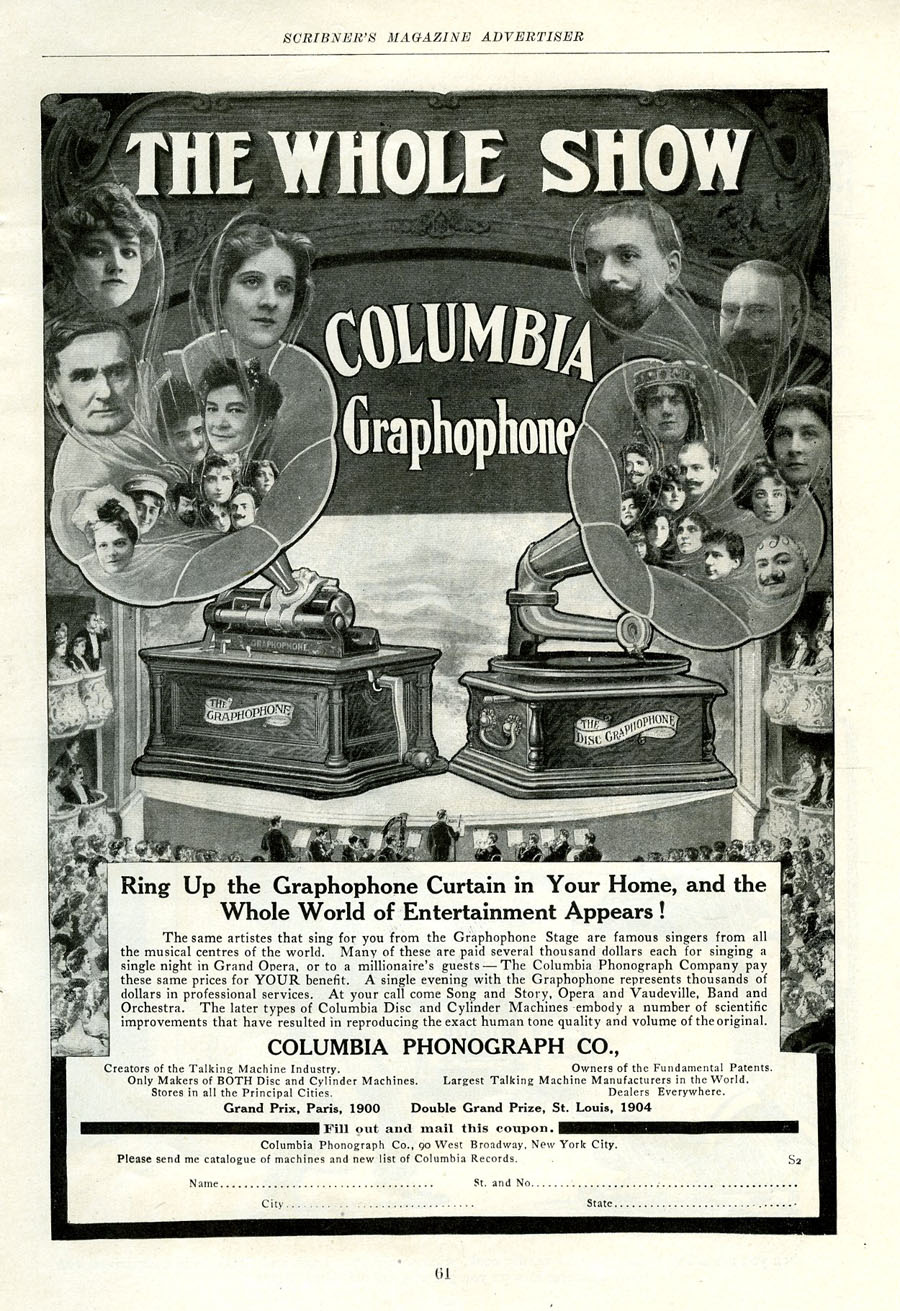
"Ring Up the Graphophone Curtain
in Your Home, and the Whole World of Entertainment Appears!"
1906
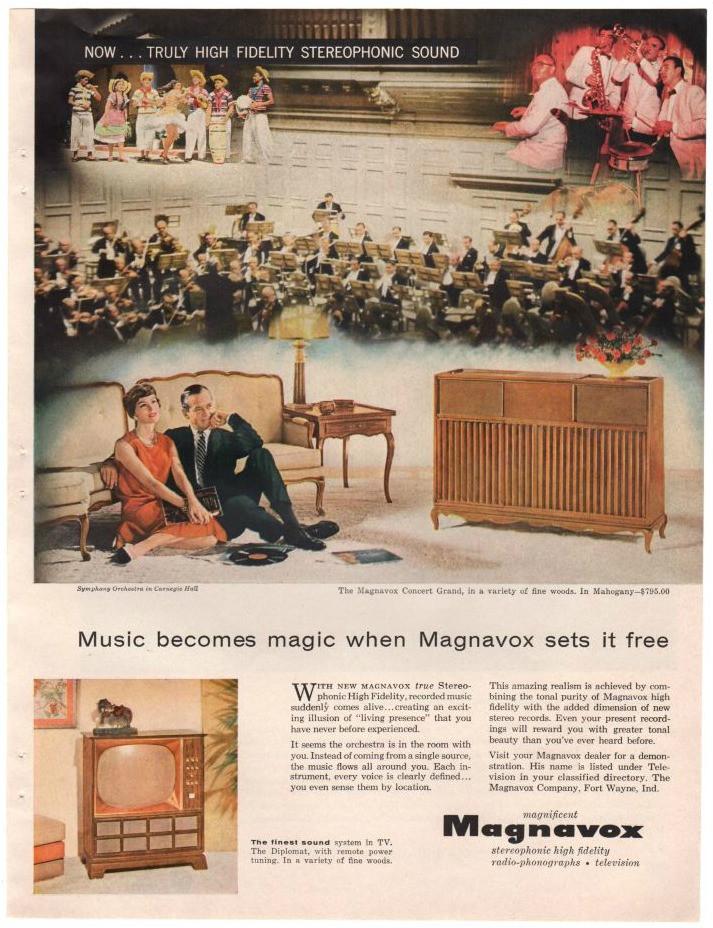
Carnegie Hall - Magnavox Stereophonic
High-Fidelity -- "recorded music suddenly comes alive...creating
an exciting illusion of "living presence...with amazing realism."
1958
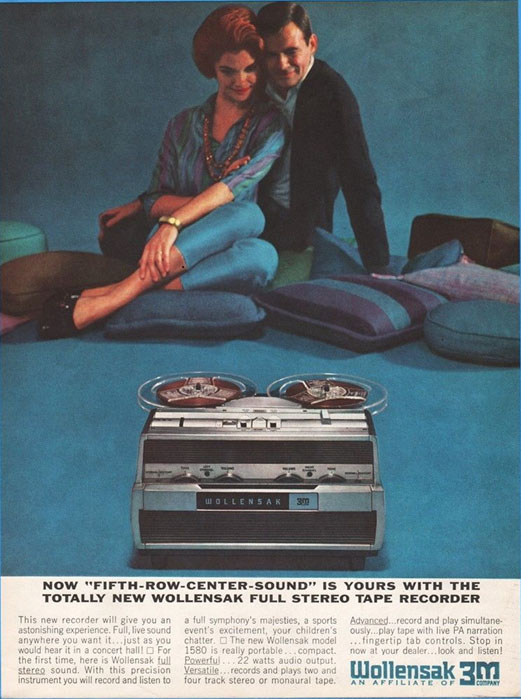
"Fifth-Row-Center-Sound"
"Full, live sound..."
Wollensak Stereo Tape Recorder 1963
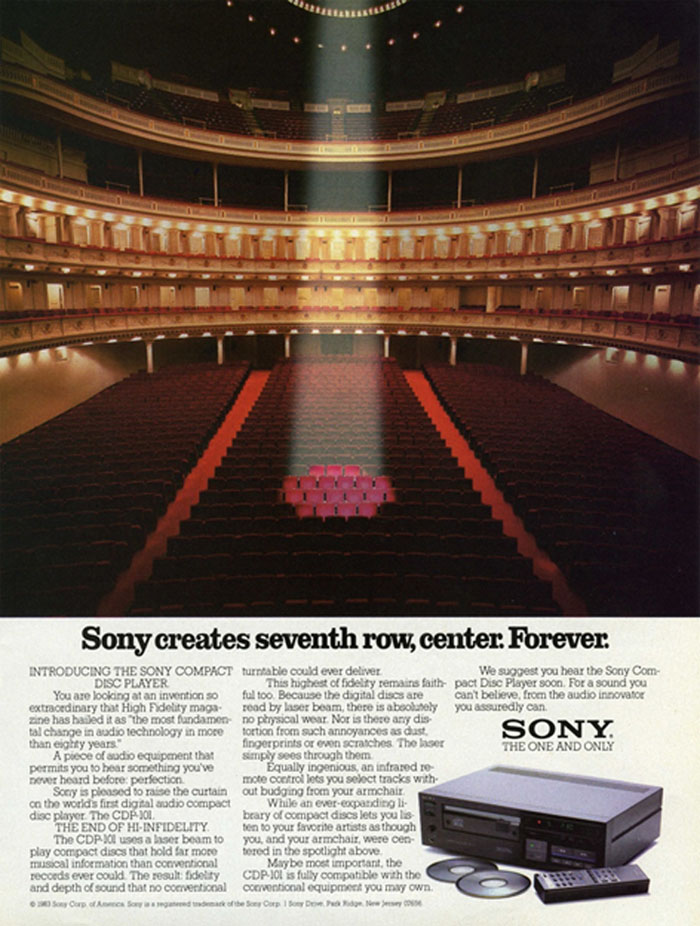
"...hear something you've never
heard before: perfection." "you listen to your favorite
artists as though you, and your armchair, were centered in the spotlight
above." (Courtesy of Sony, 1983)

Phonographia
|










































